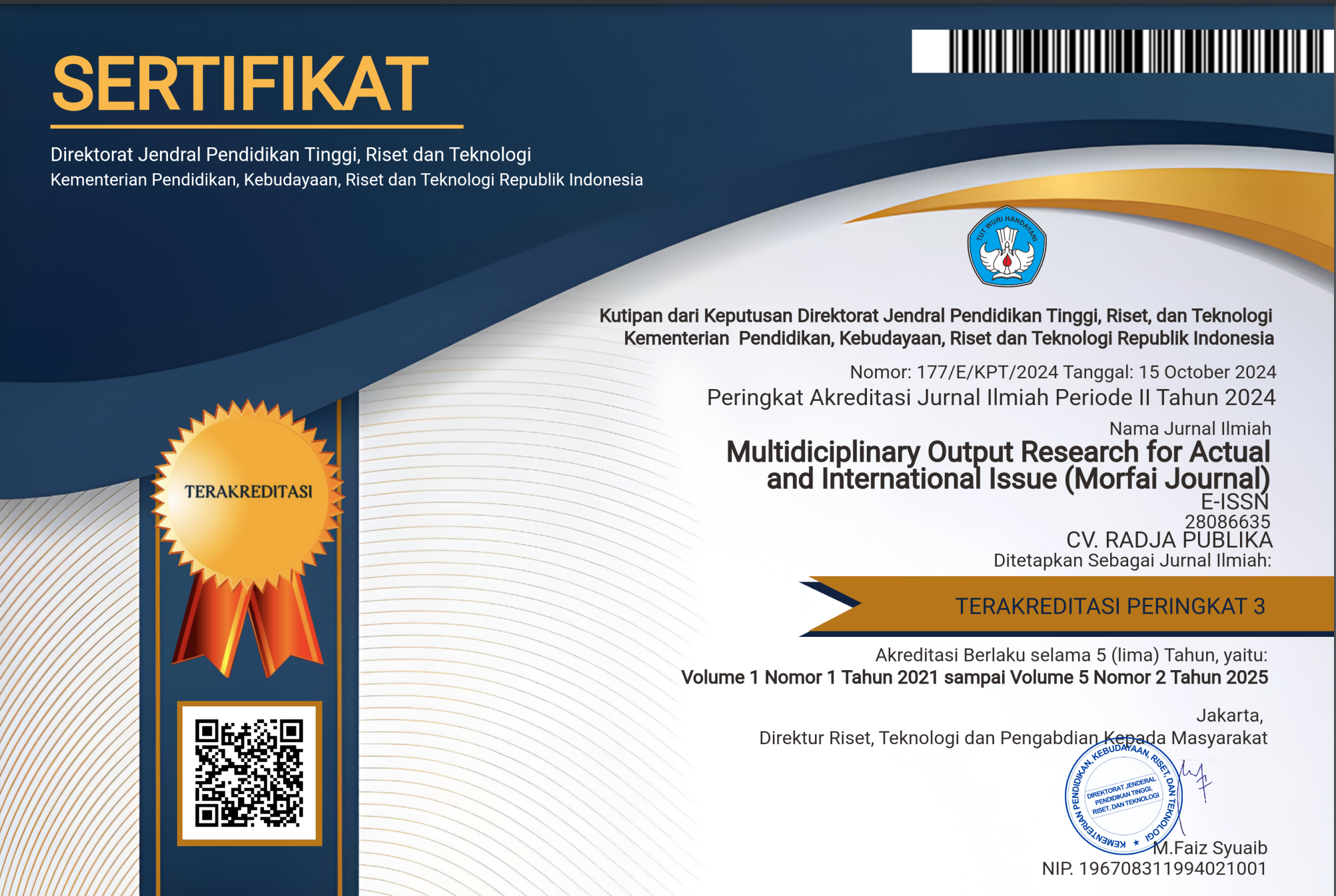THE INFLUENCE OF INTERNAL AND EXTERNAL FACTORS ON THE DELAYS OF GOVERNMENT CONSTRUCTION PROJECTS IN WEST PAPUA PROVINCE
Main Article Content
Joseph
Anton Soekiman
Chandra Afride Siregar
Construction work is a work that has a complex system because it involves various parties from the pre-contract stage to the post-contract stage so that it often causes problems of delays in completing work which can result in failure to achieve project objectives. This study aims to analyze internal and external factors that influence delays in government projects in West Papua Province, as well as to analyze the impact of these internal and external factors. The study was conducted in the West Papua Province area covering Manokwari Regency, South Manokwari, Arfak Mountains, Fakfak, Kaimana, Bintuni Bay, and Wondama Bay. The research sample was a construction company located in the West Papua Province area which was taken using the Cluster Sampling technique. The internal factor variables observed included financial problems, human resources, materials. The external variables from the government that were observed included design and planning, Government Regulations of the Special Autonomy Law. While the environmental factors observed included weather conditions. The variables of the impact of delays observed included costs, time, payment, scheduling, and productivity. The data collection methods used were interviews, questionnaires, and documentation. Measurement of variables using a Likert scale, and analyzed using the RII (Relative Importance Index) program to determine the dominant factors causing delays in the completion of construction work, and the impacts caused. This study found that the main internal factors influencing the delay of construction projects were delays in the delivery of materials from outside West Papua, and limited budget or working capital affected the smooth implementation of the project. While the main external factors were direct appointments that did not understand the specifications of the work, direct appointments of contractors from Papuan companies who were not competent in carrying out the work, and design changes made in the middle of the project increased the risk of delays. The existence of internal and external factors of delays has an impact on increasing the time needed to complete the project, rescheduling from the specified time, increasing costs used in completing the project, delays in payments, and decreasing productivity/efficiency of the workforce.
Abushaban, S. (2008). Factors affecting the performance of construction projects in the Gaza Strip [Master's thesis]. The Islamic University of Gaza.
Adriadi, A., & Solihin, A. R. (2021). Faktor-faktor penyebab keterlambatan proyek konstruksi gedung. Prosiding Konferensi Ilmiah, 1-15. http://prosiding.uika-bogor.ac.id/index.php/kiijk/article/view/379/258
Ali, A. S., Smith, A., Pitt, M., & Chan, M. (2012). Contractor's perception of factors contributing to project delay: Case studies from Libya. International Journal of Project Management, 30(1), 54-63.
Assaf, S. A., & Al-Hejji, S. (2006). Causes of delay in large construction projects. International Journal of Project Management, 24(4), 349-357.
Proboyo, B. (2019). Keterlambatan waktu pelaksanaan proyek: Klasifikasi dan peringkat dari penyebab-penyebabnya. Jurnal Manajemen Konstruksi, 7(2), 88-99.
Chan, D. W. M., & Kumaraswamy, M. M. (1997). A comparative study of causes of time overruns in Hong Kong construction projects. International Journal of Project Management, 15(1), 55-63.
Dipohusodo, I. (1996). Manajemen proyek dan konstruksi. Kanisius.
Enshassi, A., Mohamed, S., & Abushaban, S. (2009). Factors affecting the performance of construction projects in the Gaza Strip. Journal of Civil Engineering and Management, 15(3), 269-280.
Ghozali, I. (2005). Aplikasi analisis multivariate dengan program SPSS. Badan Penerbit Universitas Diponegoro.
Haseeb, M., Bibi, A., & Rabbani, W. (2011). Causes and effects of delays in large construction projects of Pakistan. Kuwait Chapter of Arabian Journal of Business and Management Review, 1(4), 18-42.
Hillson, D. (2019). Managing risk in projects. Routledge.
Ismail, S., Abdul Rahman, I., & Memon, A. H. (2013). Preliminary study on causative factors leading to construction cost overrun. International Journal of Sustainable Construction Engineering & Technology, 4(1), 57-71.
Jha, K. N., & Iyer, K. C. (2007). Critical factors affecting quality performance in construction projects. Journal of Construction Engineering and Management, 133(8), 654-662.
Kerzner, H. (2017). Project management: A systems approach to planning, scheduling, and controlling (12th ed.). Wiley.
Kwak, Y. H., & Anbari, F. T. (2009). A new approach to project management: The concept of project governance. International Journal of Project Management, 27(4), 306-318.
Megawati, L. A., & Lirawati. (2020). Analisis faktor keterlambatan proyek konstruksi bangunan gedung. Jurnal Teknik Sipil, 12(3), 112-125.
Sanaky, M. M., Saleh, L. M., & Titaley, H. D. (2021). Analisis faktor-faktor penyebab keterlambatan pada proyek pembangunan gedung asrama MAN 1 Tulehu Maluku Tengah. Jurnal Simetrik, 5(1), 33-45.
Naeem, M. (2020). Semantic-based process mining technique for healthcare processes [Master's thesis]. Queen Mary University of London.
Ogunlana, S. O., & Latham, A. C. (1996). The influence of environmental conditions on the performance of construction projects. Construction Management and Economics, 14(4), 295-304.
PMI (Project Management Institute). (2017). A guide to the project management body of knowledge (PMBOK Guide) (6th ed.). PMI.
Paramita, D. (2019). Analisis faktor penyebab keterlambatan proyek konstruksi di Karangasem, Bali. Jurnal Teknik Sipil, 10(1), 1-10.
Rudi, A. (2008). Manajemen proyek konstruksi dan faktor penentu keberhasilan proyek. Pustaka Setia.
Ariefasa, R. (2011). Strategi mengatasi keterlambatan proyek konstruksi. Jurnal Teknik Sipil, 12(2), 121-133.
Sitoyo, A., & Sodik, M. (2015). Metode penelitian kuantitatif dalam ilmu sosial. Pustaka Mandiri.
Sugiyono. (2017). Metode penelitian kuantitatif, kualitatif dan R&D. Alfabeta.
Takim, R., & Akintoye, A. (2002). Performance indicators for successful construction project performance. Association of Researchers in Construction Management (ARCOM) Conference Proceedings, 545-555.
Turner, J. R., & Muller, R. (2005). The project manager's leadership style as a success factor on projects: A literature review. Project Management Journal, 36(1), 49-61.
Utama, A. B., & Fernando, R. (2020). Kajian empiris penyebab rendahnya tingkat realisasi proyek infrastruktur kerjasama pemerintah dan swasta (KPS) di Indonesia. Jurnal Manajemen Proyek, 8(2), 77-89.
Wirabakti, D., Wijayanto, H., & Rachmawati, F. (2014). Faktor penyebab keterlambatan proyek konstruksi di Tangerang. Jurnal Teknik Sipil, 8(1), 13-21.
Yustia, R. (2018). Manajemen proyek konstruksi: Konsep dan implementasi. Graha Ilmu.









